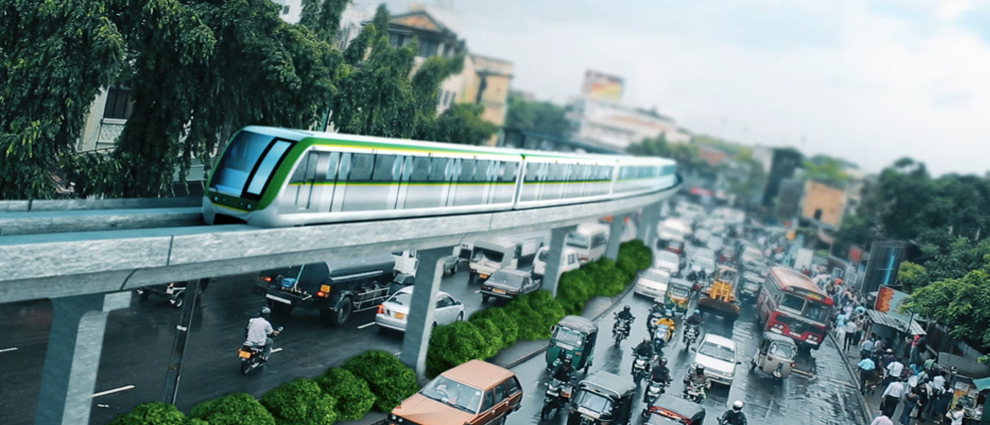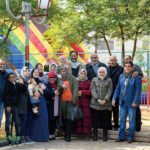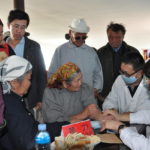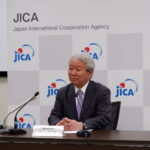The Japan International Cooperation Agency (JICA) implements a variety of projects in developing countries to promote gender equality and women’s empowerment. We take a look at some recent projects, with a focus on the women-friendly infrastructure and environment of the Delhi Metro in India and the Gender Action Plan being formulated for the Light Rail Transit System in Colombo, Sri Lanka.
In many societies, women are disadvantaged in various ways, including education, employment, and political participation, simply by virtue of their gender. In order to change this situation, the international community has taken various actions following World War II such as the establishment of the UN Commission on the Status of Women in 1946, the holding of the World Conference on Women (held for the first time in 1975) and the adoption of the Convention on the Elimination of all Forms of Discrimination against Women in 1979.
In the arena of development, the Gender and Development (GAD) approach has attracted global attention since the 1980s. Gender is socially and culturally constructed according to the values, traditions, customs and so forth shared by a particular society. GAD promotes the empowerment of women by changing the relative relationship between men and women and the institutional and social systems that discriminate against women. “Gender mainstreaming” was proposed at the 4th World Conference on Women held in Beijing in 1995 as a strategy to promote GAD. In 1997, the United Nations Economic and Social Council defined gender mainstreaming as: “The process of assessing the implications for women and men of any planned action, including legislation, policies or programs, in all areas and at all levels,” and its goal is “to achieve gender equality.”
Now, in the twenty-first century, gender mainstreaming and gender equality, and initiatives for promoting these notions, have spread throughout the world. The Sustainable Development Goals (SDGs) contained in the 2030 Agenda for Sustainable Development adopted by the United Nations in 2015 include “Achieve gender equality and empower all women and girls” (Goal 5).
Gender Equality in International Cooperation
Amid this global trend, countries have worked to redress gender-based discriminatory practices and laws with the aim of reducing gender inequality and disparities. Moreover, the perspective of gender has had a significant impact on the guidelines for international cooperation formulated by individual countries. In Japan, the Development Cooperation Charter formulated by the Cabinet in 2015 states: “In the context of gender equality and greater role of women in development, Japan will encourage the participation of women at every phase of development cooperation and be more proactive in ensuring that women share equitably in the fruits of development, while giving consideration to the possible vulnerabilities of women and their special needs.” Further, in 2016 the Development Strategy for Gender Equality and Women’s Empowerment was formulated based on the fundamental principles of the Charter, citing the priority initiatives of promoting gender responsive infrastructure and promoting women’s economic empowerment and women’s leadership in the economy and other fields.
In light of this, the Japan International Cooperation Agency (JICA) determined strategies and actions with regard to gender equality and women’s empowerment, with a focus on the priority areas of women’s economic empowerment, women’s rights and security, women’s education and lifetime health, gender responsive governance, and gender responsive infrastructure.
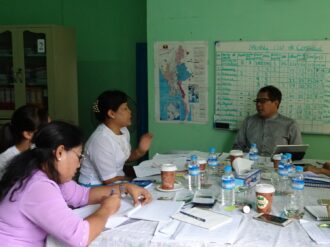
A meeting of counterparts at the information center for human trafficking in Myanmar, held as part of the Project on Capacity Development and Promotion of Networking on Assisting Victims of Trafficking (2018–2020)
COURTESY OF JICA
Based on these strategies, JICA implements various projects in developing countries. From 2009 to 2014 in Thailand, JICA implemented the Project on Strengthening of Multi-Disciplinary Teams for Protection of Trafficked Persons. The project supported the Multi-Disciplinary Team, which is engaged in activities such as rescue and protection of victims of trafficking in Thailand and neighboring countries, psychological and physical recovery in shelters, and rehabilitation and independence support through education and vocational training. JICA has implemented subsequent phases since 2018 after the completion of the projects in Myanmar and Vietnam mentioned above.
In addition, the Project on Capacity Improvement of Recovery and Reintegration Assistance for Trafficked Persons, which was implemented in Myanmar from 2012 to 2016, supports cooperation with institutions that support the rehabilitation of trafficked persons as well as capacity improvement, while the Project for the Establishment of Anti-Trafficking in Persons Hotline was implemented in Vietnam supports the establishment and operation of a hotline with the goal of protecting victims of trafficking and preventing human trafficking. Further, from 2015 to 2019, JICA collaborated with Thailand on the Project on Capacity Development on Assisting Victims of Trafficking in the Greater Mekong Sub-regional Countries (CM4TIP), thereby strengthening ties with the relevant parties in the Greater Mekong Sub-regional countries with respect to measures against human trafficking.
Women-friendly Trains
JICA is also implementing projects in the arena of infrastructure that incorporate a gender perspective. One of the reasons why the gender perspective is important in the arena of infrastructure, aside from the promotion of gender equality, is its impact on economic growth. According to a 2015 estimate by the McKinsey Global Institute in the United States, expanding women’s economic participation to the same level as that of men would increase GDP to 26% ($28 trillion) by 2025. Further, according to a report issued by the International Labour Organization (ILO) in 2019, in a survey of 13,000 companies in 70 countries, “almost three-quarters of companies that tracked gender diversity in their management reported profits increases of between 5 and 20 per cent.”
In developing countries, however, a variety of obstacles prevent women from participating in society. A report issued by the ILO in 2017 noted that the most significant factor restricting women’s participation in the workforce in developing countries is “lack of transportation.”
“Women in developing countries are vulnerable on public transport to harassment and gender-based violence. Lack of safe transportation greatly limits female participation in the workforce and in society more broadly,” says Kamei Haruko, Senior Director, JICA’s Office for Gender Equality and Poverty Reduction. “If women are guaranteed safe transportation, their participation in economic activities will increase, which in turn leads to economic growth.”
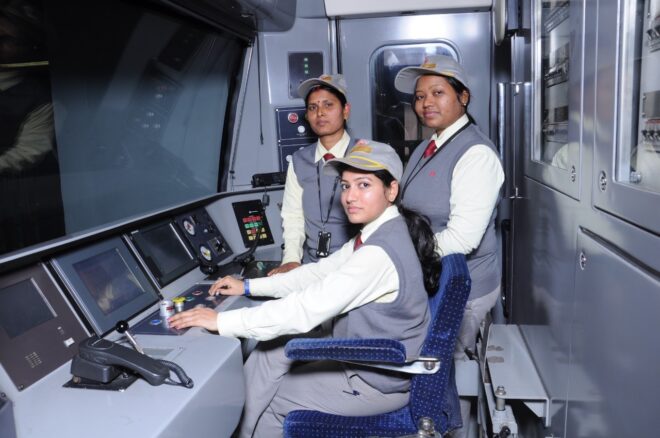
Women drivers on the Delhi Metro
COURTESY OF JICA
One JICA project that incorporates a gender perspective is the development of the Delhi Metro in India, for which it provided assistance through ODA loan and other means since the planning stage in 1995. Opened in 2002, the Delhi Metro aims to be the most user-friendly subway in the world by incorporating station buildings and cars designed with the needs of elderly, disabled, and women passengers in mind. Women-only cars were introduced on each line in 2010, with seats also reserved for women in all other cars. Escalators are equipped with “sari guard” brushes to prevent the hems of women’s saris from getting caught, while female guards and staff are stationed at major stations. The Delhi Metro Rail Corporation, which operates the Delhi Metro, is also working to create an environment that supports the needs of working women, such as granting childcare leave, opening childcare facilities, and setting up women’s dormitories.
It is also planned to incorporate a gender perspective into the ODA loan agreement signed between the Government of Sri Lanka and JICA in March 2019 for the Project for Establishment of Light Rail Transit System in Colombo. This project will construct an LRT (Light Rail Transit) system connecting the central area of Colombo and the suburbs with 16 stations distributed along 15.7 kilometers of elevated track. Construction will begin in 2021 and is scheduled for completion in 2025.
“Women’s participation in construction and public transport is low in Sri Lanka, although this is gradually changing. For example, public transport such as buses and trains do not have a single female driver,” says project director Chaminda Ariyadasa. “That’s why we believe this project will be a benchmark for gender mainstreaming in Sri Lanka.”
The Ministry of Urban Development, Water Supply & Housing Facilities, which implements the project, is currently working with JICA to formulate a Gender Action Plan (GAP) that summarizes the kinds of planned initiatives for stations, rolling stocks, construction, and operation that need to be implemented from a gender perspective. It is planned to incorporate the following initiatives into the GAP. For stations, initiatives include the installation of separate washrooms for men and women, adequate lighting, emergency alarms, CCTV cameras, and separate ticket counters for men and women, and the deployment of male and female security guards. For rolling stocks, initiatives include the installation of priority seats for persons with disabilities, women, children, and the elderly, the introduction of women-only cars, and the installation of CCTV cameras. In terms of construction, initiatives include the employment of women for construction work, provision of facilities for women at construction sites, and equal pay for equal work. In terms of operations, initiatives will include the hire of women drivers and conductors, the setting of fares and timetables that take into account women’s needs, the deployment of female staff at ticket offices and ticket gates, and awareness campaigns to prevent sexual harassment.

Chaminda Ariyadasa, project director of the Project for Establishment of Light Rail Transit System in Colombo
THE JAPAN JOURNAL
In addition to assisting in the formulation of the GAP, JICA is helping raise awareness among stakeholders by dispatching experts as well as staff from the Office for Gender Equality and Poverty Reduction to Sri Lanka, where they hold seminars and workshops on gender for staff from the organizations implementing the initiatives and other stakeholders.
“I think this project will have a significant impact on Sri Lanka’s industry. When young women see women working as drivers and engineers on the new LRT, it will be a great stimulus for women’s participation in society,” says Ariyadasa. “The project will also send a good message to the entire public transport sector in Sri Lanka regarding women’s participation.”
In its 4th Medium-Term Plan (FY2017–2021), JICA set a goal to increase the ratio of “gender projects” to 40% or more of all projects in value terms (average in the 4th quarter). Gender projects are projects that have gender equality and women’s empowerment as their main objectives, as well as projects that do not have activities for gender equality and women’s empowerment as their main objectives but nonetheless incorporate such activities.
“Japan has made various efforts to change gender stereotypes in urban transportation and elsewhere in the infrastructure arena. We would like to harness this experience when considering assistance in developing countries. Through this project in Sri Lanka, we aim to develop guidelines and tools that can be used in other projects,” says Kamei. “We would like to pursue higher quality in any projects both in infrastructure and other arenas in order to achieve gender equality.”
By Sawaji Osamu, The Japan Journal
[This article first appeared in the January/February 2020 issue of the Japan Journal.]

